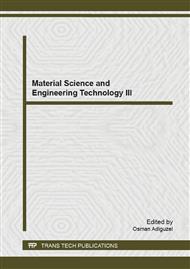[1]
Jin Wen, Jie Li, Shijun Liu and Qi-yuan Chen Preparation of copper nanoparticles in a water/oleic acid mixed solvent via two-step reduction method, Colloids and Surfaces A: Physicochemical and Engineering Aspects Volume 373, Issues 1–3, 3 January 2011, Pages 29–35.
DOI: 10.1016/j.colsurfa.2010.10.009
Google Scholar
[2]
Yasuo Gotoh, (the late) Ryo Igarashi, Yutaka Ohkoshi, Masanobu Nagur, Kensuke Akamatsu and Shigehito Deki" Preparation and structure of copper nanoparticle/poly(acrylicacid) composite films" J. Mater. Chem., 2000, 10, (11) 2548-2552.
DOI: 10.1039/b003899g
Google Scholar
[3]
S.S. Shankar, A. Rai, A. Ahmad et al. Controlling the optical properties of lemongrass extract synthesized gold nanotriangles and potential application in infrared-absorbing optical coatings Chem. Mater., 17, p.566–572 (2005).
DOI: 10.1021/cm048292g
Google Scholar
[4]
M. Goosey, R. Kellner, End-of Life Printed Circuit Boards, Intellect and the department of trade and industry, Makati City, (2002).
Google Scholar
[5]
S. Zhang, E. Forssberg, Mechanical separation-oriented characterization of electronic scrap, Resour. Conserv. Recycl. 21, 247–269, (1997).
DOI: 10.1016/s0921-3449(97)00039-6
Google Scholar
[6]
S. Zhang, E. Forssberg, B. Arvidson, W. Moss, Aluminum recovery from electronic scrap by high-force eddy-current separators, Resour. Conserv. Recycl. 23, 225–241, (1998).
DOI: 10.1016/s0921-3449(98)00022-6
Google Scholar
[7]
W.J. Hall, P.T. Williams, Separation and recovery of materials from scrap printed circuit boards, Resour. Conserv. Recycl. 51, 691–709, (2007).
DOI: 10.1016/j.resconrec.2006.11.010
Google Scholar
[8]
K. Gloe, P. Mühl, M. Knothe, Recovery of precious metals from electronic scrap, in particular from waste products of the thick-layer technique, Hydrometallurgy 25 99–110, (1990).
DOI: 10.1016/0304-386x(90)90067-c
Google Scholar
[9]
T. Oishi, K. Koyama, H. Konishi, M. Tanaka, J.C. Lee, Influence of ammonium salt on electro winning of copper from ammoniacal alkaline solutions, Electrochim. Acta 53, 127–132, (2006).
DOI: 10.1016/j.electacta.2007.06.024
Google Scholar
[10]
D. Pilone, G.H. Kelsall, Prediction and measurement of multi-metal electro deposition rates and efficiencies in aqueous acidic chloride media, Electrochim. Acta 5, 3802–3808, (2006).
DOI: 10.1016/j.electacta.2005.10.045
Google Scholar
[11]
Young Jun Park∗, Derek J. Fray, Recovery of high purity precious metals from printed circuit boards, Journal of Hazard. Mater. 164, 1152–1158, (2009).
DOI: 10.1016/j.jhazmat.2008.09.043
Google Scholar
[12]
P.A. Adhyapack, P.K. Khamora. J.W. Dadge and R.C. Alyer, Tuned optical properties of In-sito synthesized m-nitroaniline doped Ag/PVA nano-composites, J. of nanoscience &nanotechnology vol. 6(7), 2141-2146.
DOI: 10.1166/jnn.2006.345
Google Scholar
[13]
Sondi, D.V. Goia and E. Matijevć, J. Colloid Interface Sci. 260, 75, (2003).
Google Scholar
[14]
D. Wang, C. Song, Z. Hu and X. Zhou Synthesis of silver nanoparticles with flake-like shapes. Materials letters, Vol. 59(14-15}1760-1763, (2005).
DOI: 10.1016/j.matlet.2005.01.061
Google Scholar
[15]
Mahmoud A. Rabah Preparation of Size Controlled Silver on Carbon from E-waste by Chemical and Electro-Kinetic Processes, World Academy of Science, Engineering and Technology J. 80 321-26The electrodeposition method is considered by many as one of the most suitable and easiest. The electrolyte used for the process is an acidified aqueous solution of copper sulfate with specific additives The electrodeposition method is considered by many as one of the most suitable and easiest. The electrolyte used for the process is an acidified aqueous solution of copper sulfate with specific additives The electrodeposition method is considered by many as one of the most suitable and easiest. The electrolyte used for the process is an acidified aqueous solution of copper sulfate with specific additives.
DOI: 10.1002/pssa.201600159
Google Scholar


